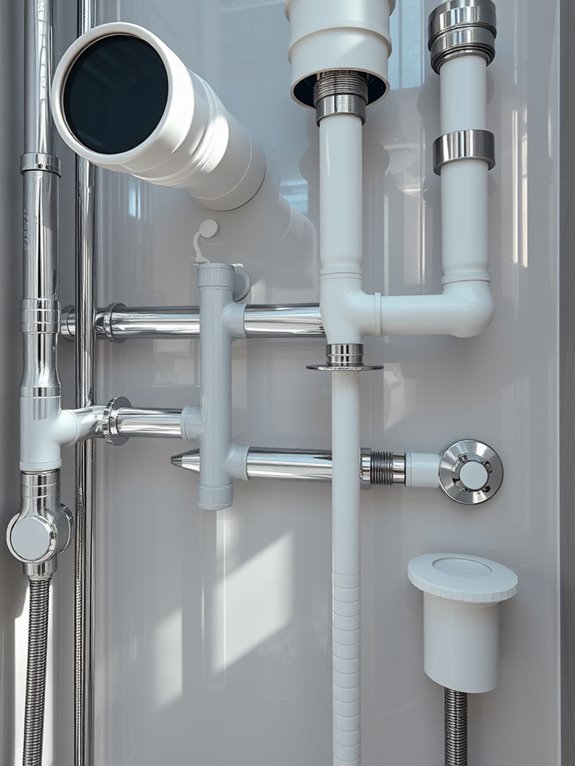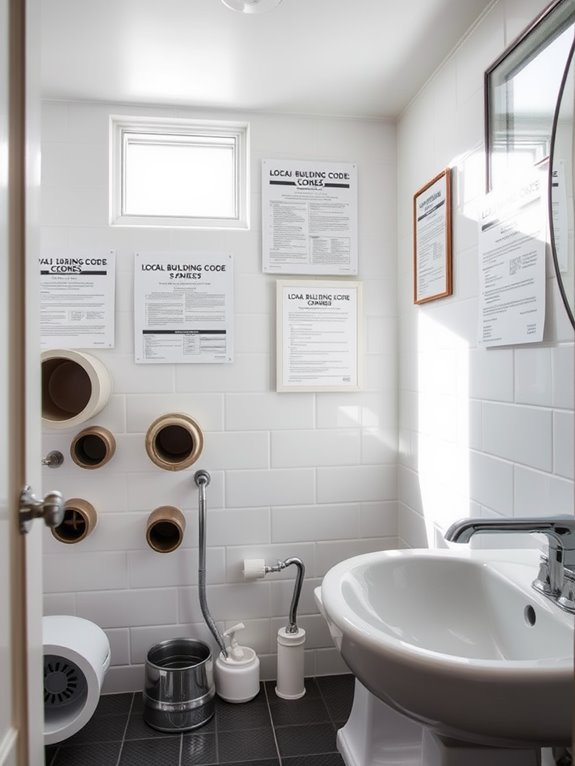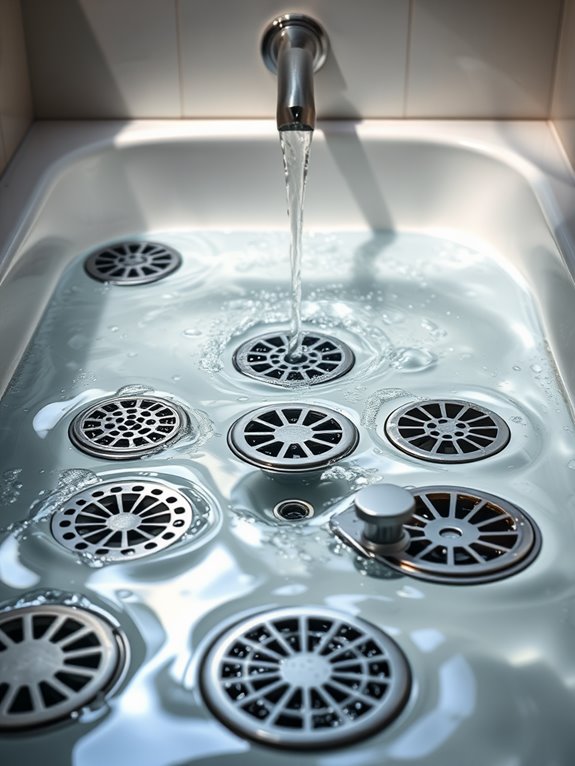Bathroom Plumbing Drain Sizes: A Complete Reference Guide
When it comes to bathroom plumbing drain sizes, you’ll usually find sinks using a 1.25-inch drain, toilets needing a 3-inch drain, and showers or tubs requiring a 2-inch pipe. It’s important to match these sizes to your plumbing system for peak performance. Additionally, local building codes may vary, so double-check those before starting any renovations. Understanding these specifications will help you avoid clogs and costly repairs, and there’s more to discover about efficient drainage systems.
Understanding Bathroom Drain Systems

Bathroom drain systems are crucial for maintaining a clean and functional space. You rely on these systems to efficiently remove wastewater from sinks, showers, and toilets.
Understanding how they work helps you troubleshoot issues before they escalate. Each component, from pipes to traps, plays an important role in preventing clogs and odors.
Regular maintenance, like cleaning and inspections, guarantees everything flows smoothly. When you know the basics, you can address minor problems yourself or communicate effectively with a plumber.
Being proactive about your bathroom drain system keeps your space sanitary and reduces the risk of costly repairs later on.
If you found this helpful, you’ll love this post too! What is a Plumbing Nipple: Essential Guide for Homeowners
Standard Drain Sizes for Sinks
When it comes to sink drains, standard sizes typically fall between 1.25 inches and 2 inches in diameter. Most bathroom sinks use a 1.25-inch drain, which effectively handles water flow and prevents clogs.
However, if you’re dealing with a larger vessel sink or a commercial setup, you might need a 1.5-inch or even a 2-inch drain. It’s important to match the drain size with your plumbing system to guarantee peak performance.
Also, remember that the size of the drain will affect the type of sink you can install, so choose wisely for your bathroom renovation or upgrade.
Don’t miss out on related tips: Read this next: How to fix a broken PVC drain pipe
Toilet Drain Size Requirements

Choosing the right toilet drain size is essential for guaranteeing proper function and preventing issues down the line.
Most toilets require a 3-inch drain pipe, while some older models might use a 2-inch pipe. It’s critical to check your local plumbing codes, as they can vary. A 3-inch pipe allows for better waste flow and reduces the risk of clogs.
If you’re installing a new toilet, make sure the drain size matches the new unit. Proper sizing guarantees efficient drainage, minimizes odors, and prolongs your plumbing system’s life.
Don’t overlook this important aspect of your bathroom renovation!
Here’s another post you might find useful: How To Clean A Bathroom For A Bond Clean?
Shower and Tub Drain Dimensions
Shower and tub drains typically require a 2-inch diameter pipe to guarantee adequate water flow and prevent clogs. This size is standard for most residential installations, ensuring that water drains quickly and efficiently.
When selecting a drain, consider the type of drain cover and the slope of your plumbing to optimize performance. Also, keep in mind that older homes may have different requirements.
If you’re renovating, check local plumbing codes for compliance. Remember, using the right size pipe can save you from future plumbing headaches and costly repairs. So, make sure you get it right the first time!
Here’s another post you might find useful: Why Are Plumbing Services Expensive? Unveiling the Real Costs
Venting and Drainage Considerations

While ensuring your bathroom plumbing functions efficiently, you can’t overlook the importance of proper venting and drainage considerations. Adequate venting prevents pressure build-up, allowing wastewater to flow smoothly through your pipes. When planning, consider both the size and placement of vents to avoid clogs and backups.
Here’s a quick reference for common vent sizes:
| Fixture | Recommended Vent Size | Minimum Distance from Drain |
|---|---|---|
| Toilet | 3 inches | 6 feet |
| Sink | 1.5 inches | 4 feet |
| Shower | 2 inches | 5 feet |
| Bathtub | 2 inches | 5 feet |
| Laundry Tub | 2 inches | 6 feet |
Common Drain Pipe Materials
When choosing drain pipe materials, you’ll often find PVC and cast iron as popular options.
PVC is lightweight and resistant to corrosion, making it an attractive choice for many homeowners.
On the other hand, cast iron offers exceptional durability and soundproofing benefits that can’t be overlooked.
PVC Pipe Advantages
PVC pipes stand out as a popular choice for bathroom plumbing due to their numerous advantages.
They’re lightweight, making installation a breeze for DIY enthusiasts. You won’t have to worry about rust or corrosion, as PVC is resistant to moisture and chemicals.
Additionally, these pipes offer excellent flow characteristics, reducing the risk of clogs. Their smooth interior surfaces help minimize friction, allowing wastewater to flow freely.
PVC is also budget-friendly, providing a cost-effective solution without sacrificing quality. Plus, it’s easy to cut and join, enabling you to adapt your plumbing system with ease.
You’ll appreciate the long-lasting performance they offer.
Cast Iron Durability
Although modern materials like PVC have become popular, cast iron remains a top choice for bathroom plumbing due to its exceptional durability.
When you install cast iron pipes, you’re investing in a material that can withstand extreme temperatures and resist corrosion effectively. This longevity means fewer replacements and lower maintenance costs over time.
Plus, cast iron’s density helps to minimize noise from flowing water, creating a quieter home environment.
While it may be heavier and more challenging to work with than PVC, the benefits of cast iron—especially in high-use areas like bathrooms—often outweigh the drawbacks, ensuring reliable performance for years to come.
Local Building Codes and Regulations

When you’re planning your bathroom plumbing, it’s essential to understand local building codes and regulations.
These codes dictate everything from drain sizes to permitting requirements, ensuring your project meets safety and efficiency standards.
Compliance isn’t just a formality; it can save you from costly fines and future headaches.
Understanding Local Codes
Understanding local building codes and regulations is essential for any plumbing project, as these rules dictate the acceptable standards for drain sizes and installation practices.
Before starting, check your area’s specific requirements, as they can vary considerably. These codes guarantee your plumbing system operates efficiently and safely, preventing costly mistakes.
You’ll need to know the minimum pipe diameters, slope requirements, and venting specifications. Compliance with these codes not only assures safety but can also save you from potential fines or issues during inspections.
Always consult with your local authority or a licensed plumber to stay informed and compliant.
Permitting Requirements Overview
Before you plunge into any bathroom plumbing project, it’s important to familiarize yourself with the permitting requirements in your area. Each locality has its unique regulations, and obtaining the right permits can save you from potential fines or project delays.
Check with your local building department for specific guidelines on plumbing permits. You’ll typically need to submit plans that detail your intended work, including drain sizes and layouts.
Don’t forget to verify if inspections are required before, during, or after your project. Staying informed about these requirements guarantees your plumbing work complies with local standards and keeps your home safe.
Compliance With Regulations
Compliance with local building codes and regulations is vital for any bathroom plumbing project, as it guarantees your work meets safety and quality standards.
Before starting, familiarize yourself with your area’s specific plumbing codes. These regulations often dictate the size and type of drains, pipe materials, and installation methods. Ignoring these rules can lead to costly fines, delays, or safety hazards.
Always consult your local building department for the most up-to-date information. Additionally, hiring a licensed plumber can assure compliance, saving you time and headaches in the long run.
Don’t overlook this vital step in your bathroom renovation.
Factors Affecting Drain Size Selection
Several key factors influence your choice of drain size in bathroom plumbing.
First, consider the type and number of fixtures you’re installing. More fixtures generally require larger drains.
Second, think about the layout of your plumbing system; longer runs may need bigger pipes to prevent clogs.
Third, account for the local climate; freezing temperatures can affect drain performance.
Finally, consider future renovations or additions to your bathroom, as they might necessitate larger drains.
Maintaining Proper Drainage Flow

To maintain proper drainage flow in your bathroom, it’s essential to regularly inspect and clean your drains.
Start by removing hair and debris from drain covers and stoppers. Use a plunger or plumbing snake to clear any blockages further down the line.
You should also check for signs of leaks or corrosion in pipes, as these can hinder flow. Avoid pouring grease or non-biodegradable items down the drain, as they can create clogs.
Finally, consider running hot water through the drains occasionally to help dissolve any buildup.
Keeping drains clear guarantees efficient drainage and prevents costly plumbing issues.
Tips for Upgrading Bathroom Drain Systems
Maintaining clear drains is just the beginning; if you’re looking to upgrade your bathroom drain systems, there are several factors to take into account. First, consider the size of your pipes. Larger pipes can handle more water flow, reducing clogs. Next, choose durable materials like PVC or ABS for longevity. Also, think about adding a drain trap to prevent odors. Finally, verify your plumbing layout supports proper drainage.
| Factor | Recommendation |
|---|---|
| Pipe Size | At least 2 inches |
| Material | PVC or ABS |
| Drain Trap | Yes |
| Slope | 1/4 inch per foot |
Conclusion
In summary, understanding bathroom plumbing drain sizes is essential for effective drainage and overall bathroom functionality. Did you know that nearly 70% of plumbing issues stem from improper drain sizing? By following the guidelines outlined in this guide, you can avoid costly repairs and guarantee your bathroom operates smoothly. Whether you’re upgrading or just maintaining, keeping the right drain sizes in mind will save you time and hassle in the long run.


